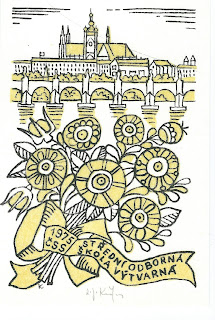About a year ago I blogged about my new hobby of collecting Czech exlibris and other small prints. Well, the collection has grown a lot since then.
In addition to exlibris (bookplates), a significant part of the collection are PF's or "pifees" as the Czechs call them. Pifees are New Year greetings cards. The PF stands for Pour Feliciter. As you can see the term is French, which was spoken at high levels of Czech society at the start of the 19th century, when Count Karl Chotek of Chotkow and Wognin is said to started the fashion for the PF abbreviation.
The cards were often commissioned from the artist by the family and sent to friends. As you can see many are signed by the artist and were by their very nature limited editions. One of the joys of PFs is the way they reflect not only the artist but the interests and characters of the commissioners.
Not all PFs are/were commissioned. Some are designed and sent by the family. My first experience of PFs were when I received them from my Czech friend, Hannah. At the time I took them to be home-made Christmas cards. But now I understand them to be another sign of Hannah's Czech roots.
Note the artists featured above are in order: Antonova, Vaculka, Kaspar, Stech and Mezl. The more sharp-sighted among you will have noticed that Mezl's Pf is a print of Cesky Krumlov.









